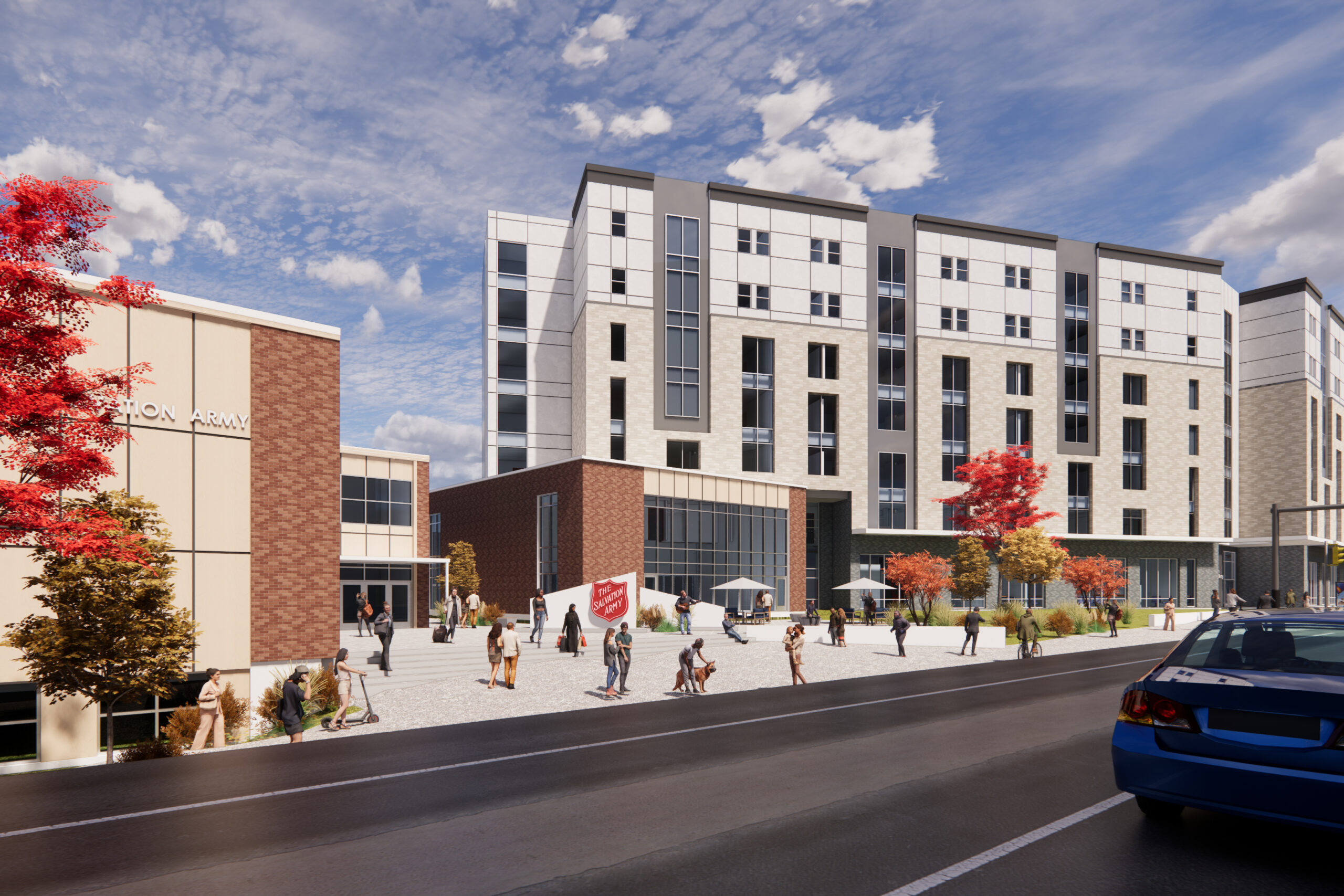Hope on Main
by Robert Mitchell

Artist rendering of The Salvation Army’s Hope on Main Street family shelter and apartment building project, phases 1 and 2, in Buffalo, N.Y.
The Salvation Army is meeting a major housing need in Buffalo, while creating opportunities to share God’s love.
Jesus replied, “Foxes have dens and birds have nests, but the Son of Man has no place to lay his head.”
—LUKE 9:58
Almost 30% of people live below the poverty line in Buffalo, N.Y., where the city’s housing crisis is so dire that The Salvation Army is embarking on a $100 million project called “Hope on Main” to help address the issue.
“In some of our neighborhoods, especially on the East Side, one in four households are experiencing a housing crisis,” says Major Annette Lock, executive director of The Salvation Army’s Buffalo Area Services. “So, at any given time, there are people falling into eviction and trying to find shelter placements and apartments. The availability of livable, safe, decent, dignified housing is just very short. Our statistics tell us we have the oldest housing stock in the nation.”
Lock says Salvation Army case managers work every day with clients to try to find housing, but a study by the city showed Buffalo’s housing stock is short about 24,000 units. Buffalo Mayor Byron Brown has said housing will be a major focus of his administration.
“One of the greatest barriers is just finding available housing to put families into,” Lock says. “We see it daily, and the statistics are showing that it’s just a critical situation. I know we’re seeing this across the nation and New York state, but we’re facing it hard here in Buffalo.”
Laura Genco, the campaign coordinator for Hope on Main, says the holds placed on evictions during the COVID-19 pandemic are expiring and leaving people in dire straits. Hundreds of homeless people are being housed in hotels.
“Everyone is finding themselves in trouble, and we’ve got a really large homeless population right now,” Genco says. “The sooner we can get some affordable housing in this city, the better.”
Buffalo Area Services spent several years working through strategic planning, and a 2019 program study identified a need for housing, according to Lock.
“We were aware at that time how bad the crisis was, and of course, it’s been only widening since the pandemic,” Lock says. “We started looking for ways that we could have a response to the housing crisis. We determined we wanted to be able to build affordable housing.”
A phased approach
Planners also factored in The Salvation Army’s aging infrastructure and the kinds of programs it wants to provide. Buffalo Area Services has been offering emergency housing for 60 years, but the shelter facility has “aged out of its usefulness,” Lock says, and needs to be replaced. The Salvation Army’s Kensington Corps building is also aged.
The Salvation Army has embarked on a three-phase plan:
Phase 1: Rebuild the existing family shelter to help provide residents with a sense of hope and dignity. “We knew that would be the first pillar of our long-term plan,” Lock says. “We’ve gotten to the point where a Band-Aid will no longer suffice.”
Phase 2: After moving families into the new facility, Buffalo Area Services will demolish the existing shelter and two other buildings to make room for an apartment complex with 144 units ranging from studios to two-bedrooms. Along the back of the property will be 17 three-bedroom affordable townhouses.
Phase 3: The Salvation Army will rebuild the Kensington Corps in the eastern part of Buffalo and turn it into a church and community center for youth programming. The current corps, built in 1933, doesn’t have enough room for what The Salvation Army wants to offer.
“The poverty rate in that part of the community is high, and the need there is dire,” Lock says. “We know our response needs to be large. We have some great programs and we’re doing some great work over there right now, but the facility is not useful for what we need it to be.
“This project would have an enormous impact on the housing crisis in the community, as well as meeting other needs for education, employment, and all the other services that are already provided by Buffalo Area Services.”
In 2022, a mass shooting at a Tops supermarket in East Buffalo put a spotlight on the area, Genco says. “Everyone is realizing the inequities faced by the people on the East Side.”
The Salvation Army hopes to break ground on Phase 1 this spring. Lock says fundraising is 70% to 75% complete for that $16 million portion of the project, which involves a complicated brownfield remediation. She expects Phase 1 to take about 18 months to complete.
While Phase 1 is being built, Lock says, the planning will move into high gear for Phase 2, which is expected to cost around $70 million. The new apartments and townhouses will include supportive housing through a partnership with the state, allowing The Salvation Army to provide services to people with special needs, substance abuse and mental health problems, and youth aging out of foster care.
“There will be funding to provide daily care and assistance and advocacy to individuals facing those challenges,” Lock says. “We’re looking forward to being able to really enhance the kinds of services we’re offering. It’s not only getting people housed, which is critical, but providing the services that help them to maintain stability and function well in the community.”
Housing and help
The funding for the first two phases will come from a mix of state and federal grants, but Phase 3 will cost $14 million and the funding will come mostly from private donors and the equity in the project. Genco says the overall funding for Hope on Main will include 85% government funding, with the balance coming from private donors and foundations.
If everything stays on track with no delays, Lock expects the project to be completed sometime in 2027. The Salvation Army would continue to raise money for an endowment to help with maintenance.
Lock says Buffalo Area Services consulted with The Salvation Army’s senior Booth Residence in Cincinnati, Ohio, on many issues, including financing. The Booth Residence is attached to The Salvation Army’s Center Hill Corps; The Salvation Army’s Buffalo Citadel will sit on the same complex as the new housing.
Lieutenant Arren Boyd, the pastor of the Kensington Corps, says the current building has no gym and is not accessible to people with disabilities. He is excited to have a larger building for a food pantry, hot meals, coat distribution, and youth programming.
“The project is going to greatly expand the amount of people we can reach through our programs because our current corps building is very small,” he says. “We can only take in so much. We’ll be able to start new programs and have space for our music program and welcome more children for all we do.

“We have hopes of our corps congregation growing because in our community we have a big population of senior citizens who used to attend the corps but don’t anymore because we don’t have the handicapped accessibility.”
Boyd envisions an after-school program operating out of the community center to provide a safe location for at-risk children in the area to come and learn music and learn about Christ.
The Kensington Corps also sees the results of the housing crisis firsthand, Boyd says. The corps serves food out of its canteen and hosts a hot sit-down dinner twice a week.
“We get a lot of people who are unhoused to that program,” Boyd says. “They can’t take canned goods because they don’t have a place to live or store canned goods or a place to cook. That’s why they come for our hot meals. They can sit down and have a meal that they can eat here.”
The Empire State Division and Eastern Territorial Headquarters have been “enormously supportive.” Colonel Ivan K. Rock, who is now at THQ, was the former divisional commander covering Buffalo and instructed Buffalo Area Services to get the plan moving in the direction God wanted for Buffalo.
“A shortage of appropriate housing is an issue throughout the territory,” Rock says. “We’re so proud of the visionary Salvation Army leaders in Buffalo who have persisted in finding a solution to this problem. Soon, individuals and families in critical need will not only find safe and adequate housing. They will have a place to call home.”
God in the details
“Once the vision began to really take shape,” Lock says, “and we were all starting to understand what God was laying on our hearts, and really the direction God wants us to go with this, we have been finding support across the board. We’re seeing a lot of hopefulness about this project coming to fruition.”
While a housing project might not seem spiritual at first blush, “it’s all spiritual,” Lock says—and a great example of what The Salvation Army does.
“I think from the very beginning, our part of the project has been the praying over it and really waiting for God to identify what He wants from us and how He wants us to move,” she says. “It’s trusting Him. This is way bigger than we are, and we absolutely know day to day that we can’t do this without Him. The whole thing in that respect is completely trusting and depending in faith that God is going to bring this about.”
Lock and others at Buffalo Area Services are excited, she says, because the project “enhances our opportunities to introduce people to Jesus” and the gospel. About 260 people will be living in the complex at any given time, and Salvation Army officers will provide pastoral care.
Residents will also have three spots to worship around the new complex, including a chapel.
“It opens up more opportunities for the things we as The Salvation Army exist for and the things we’re doing day to day,” Lock says.

